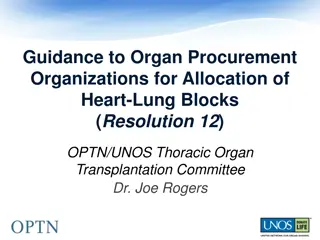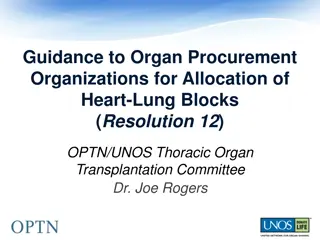ICS 143 - Principles of Operating Systems
The principles and techniques of memory management in operating systems, including swapping, contiguous allocation, paging, and segmentation. Understand the importance of virtualizing resources and controlling overlap, protection, and translation of memory.
1 views • 52 slides
Resource Allocation Review Webinar: Enhancing School Improvement Practices
Delve into the essential aspects of Resource Allocation Reviews in the educational setting through this webinar provided by the Office of School and District Improvement. Gain insights on the requirements, tools, and significance of conducting Resource Allocation Reviews to enhance school improvemen
0 views • 25 slides
Java Allocation and C2
Java object allocation and escape analysis play crucial roles in memory management and performance optimization within the Java Virtual Machine (JVM). This comprehensive overview covers topics such as object vs. scalar allocation, object allocation mechanisms, hotspot escape analysis, ideal and conn
2 views • 22 slides
Implementing Address Spaces: Base + Limit Registers
Address spaces, base + limit registers, and contiguous allocation are essential concepts in operating systems. Real mode memory addresses lack isolation between processes and pose limitations on multitasking. Virtual memory introduces virtual address spaces, requiring translation to physical address
3 views • 11 slides
Understanding File Allocation Strategies in Operating Systems
Explore various file allocation schemes like extent-based systems, linked allocation, file allocation table (FAT), indexed allocation, and combined schemes used in operating systems. Learn about their pros and cons, including details on maximum file size calculations based on disk block sizes and po
0 views • 20 slides
Operating System: File Allocation Methods
File allocation methods in operating systems determine how files are stored in disk blocks. The main methods include Contiguous Allocation, Linked Allocation, and Indexed Allocation. Contiguous Allocation involves allocating blocks in a contiguous manner for efficient disk space utilization and fast
0 views • 14 slides
Understanding AARCH64 Linux Kernel Memory Management
Explore the confidential and proprietary details of AARCH64 Linux kernel memory mapping, virtual memory layout, variable configurations, DDR memory layout, and memory allocation techniques. Get insights into the allocation of physically contiguous memory using Continuous Memory Allocator (CMA) integ
0 views • 18 slides
Proposed Changes to Forward Capacity Cost Allocation
The document discusses proposed changes to the allocation of forward capacity costs effective June 1, 2020. It highlights the need for transparency in cost allocation, focusing on zonal demand curves and the Marginal-Reliability Impact. The current opaque method is critiqued for potential non-intuit
0 views • 47 slides
Dynamic Memory Allocation in Computer Systems: An Overview
Dynamic memory allocation in computer systems involves the acquisition of virtual memory at runtime for data structures whose size is only known at runtime. This process is managed by dynamic memory allocators, such as malloc, to handle memory invisible to user code, application kernels, and virtual
0 views • 70 slides
Designing 9-Bit RU Allocation Subfield for EHT Trigger Frame in IEEE 802.11-20
IEEE 802.11-20/1845r2 presents a proposal for enhancing the RU allocation subfield design in the EHT Trigger frame to accommodate bandwidth support up to 320MHz and multiple RU or MRU allocations for UL MU transmissions in the 11be standard. The modification addresses inconsistencies in MRU mapping
0 views • 34 slides
IEEE 802.11-20/0985r5 RU Allocation Subfield Design in EHT-SIG
The document discusses the design of subfields in EHT-SIG for RU allocation in IEEE 802.11be, focusing on reducing overhead by considering supported large-size MRU combinations. It addresses concerns on entries overhead in the RU allocation subfield table and the clarity of support for specific MRU
3 views • 24 slides
Overview of HE-BCI Process for HEIF Allocation
Explore the detailed process of HE-BCI data extraction, categorization, and submission for Higher Education Innovation Fund (HEIF) allocation. Understand the key tables and activities involved, including research, business services, community engagement, and intellectual property. Learn how the HEIF
0 views • 6 slides
Understanding How the University Operates: A Comprehensive Overview
Slides and diagrams have been prepared to aid in the orientation of new staff members at the University, detailing the governance structure, decision-making processes, and financial allocation models. Key bodies include the Council, University Executive, and Senate, each playing unique roles in shap
1 views • 9 slides
IEEE 802.11-20/0479r0 240 MHz Channelization Options
The document discusses agreements on 240 MHz channelization in IEEE 802.11-20/0479r0, presenting three options: contiguous non-overlapping channels, any combination of three consecutive 80 MHz channels, and puncturing of a 320 MHz channel. Various considerations and questions are raised regarding th
0 views • 12 slides
Overview of Responsibility Center Management (RCM) at Indiana University Bloomington
Indiana University Bloomington implements the Responsibility Center Management (RCM) model for resource allocation, focusing on tuition revenue distribution, assessing central expenses, advantages and disadvantages of RCM, major revenue sources allocation, and central expenses allocation. RCM emphas
0 views • 11 slides
Risk Allocation for Allocation Wells in Energy Law
Definition of allocation wells in energy law, advantages and disadvantages, lessees' rights, allocation of production to mineral owners, and legal cases related to pooling agreements. The content discusses various aspects of risk allocation for unagreed horizontal wells and the importance of clear a
0 views • 16 slides
Contiguous UL CA Architecture Overview
This document discusses the architecture and capabilities of intra-band contiguous UL carrier aggregation, focusing on issues related to multiple transmit chains, MIMO support, and potential MPR improvements. It also covers topics like ACLR MBW position, inner and outer contiguous allocation definit
4 views • 15 slides
Spatial Stream Allocation in IEEE 802.11-20 Trigger Frames
The document discusses spatial stream allocation in IEEE 802.11-20 trigger frames, specifically focusing on the SS Allocation subfield. It explains how trigger frames allocate resources for TB PPDU transmissions and solicit User Info fields, detailing the RU Allocation and SS Allocation subfields. T
3 views • 15 slides
Vocabulary Unit #12 Definitions and Examples
Learn the meanings of vocabulary words such as absolve, caricature, clangor, contiguous, cupidity, deleterious, enhance, enthrall, and extenuate with their synonyms and usage examples in sentences. Enhance your vocabulary with vivid imagery and contextual understanding to improve word usage in your
0 views • 21 slides
Solving Maximum Contiguous Subarray Sum Problem with Dynamic Programming
Explore the concept of finding the maximum contiguous subarray sum using dynamic programming as an improvement over divide and conquer algorithms. Learn the steps of defining the objective, writing recurrences, designing memoization structures, and implementing iterative algorithms. Delve into the d
1 views • 32 slides
Memory Management Strategies in Operating Systems
Memory management in operating systems involves organizing and managing main memory efficiently. It includes strategies like fetch, placement, and replacement to optimize the usage of main storage resources. Allocation methods such as bare machine and single-user contiguous storage play a crucial ro
2 views • 26 slides
Current Climate and Drought Conditions in Nebraska - November 17, 2015
Despite some areas receiving good rains in late spring and early summer, approximately 25.18% of the contiguous U.S. is currently experiencing drought conditions (D1 or worse). The National Drought Mitigation Center at the University of Nebraska-Lincoln School of Natural Resources provides an update
0 views • 38 slides
Enhancing Heart-Lung Allocation Policy for Organ Transplantation
This project focuses on improving the allocation of heart-lung blocks for organ transplantation by providing clear guidelines to Organ Procurement Organizations (OPOs). The goal is to ensure consistent practices among OPOs across the country, promoting fairness and efficiency in organ allocation. Th
0 views • 11 slides
Understanding Dynamic Memory Allocation in Programming
Dynamic memory allocation is a crucial concept in programming where programmers use allocators like malloc to acquire memory at runtime for data structures. This process involves managing the heap, maintaining variable-sized blocks, and utilizing functions like malloc, free, calloc, realloc, and sbr
0 views • 33 slides
Update in Liver and Intestine Allocation Policies for Spring 2019
The recent updates in liver and intestine allocation policies for Spring 2019 include eliminating region and DSA from the allocation model, prioritizing medical urgency and proximity, enhancing pediatric candidate considerations, and adjusting weights for DCD and elderly donors. Acuity Circles Alloc
0 views • 15 slides
Changes in Capacity Allocation Regulations for Gas Infrastructures in Portugal
The new regulation in Portugal brings significant changes in capacity booking and trading to promote convergence with CAM NC and enable a secondary market. Major changes include ex-ante payment of capacity rights, capacity allocation via a booking platform, and enhancement of liquidity in the second
0 views • 13 slides
Understanding Memory Layout and Allocation in Computer Systems at Carnegie Mellon University
Exploring the memory layout and allocation in computer systems through lectures at Carnegie Mellon University, focusing on topics such as buffer overflow vulnerability protection, unions, shared libraries, stack, heap, data locations, addresses, and practical memory allocation examples. The content
1 views • 55 slides
Effective Allocation Strategies for Decision-Making
Explore various allocation strategies such as Majority Rule, Random Selection, Authority, and Competition through a scenario of deciding who gets the candy. Analyze the efficiency and fairness of each strategy, consider the balance between economic efficiency and equity, and envision potential impac
0 views • 8 slides
Comparison between Array and Linked List Data Structures
Linked lists and arrays are commonly used data structures in programming. Linked lists offer flexibility in size changes and efficient rearrangement of elements, while arrays provide direct access to elements based on their index. Linked lists involve pointers connecting elements, allowing for dynam
0 views • 24 slides
3GPP Voting Rights Algorithm: Contiguous-3 Solution Evaluation
This evaluation delves into the advantages and disadvantages of the 3 Contiguous-3 solution within the 3GPP voting rights algorithm. It explores scenarios to test the algorithm's effectiveness in granting and revoking voting rights based on meeting attendance types. The evaluation includes diverse h
0 views • 10 slides
Divide and Conquer Algorithms - Dr. Maram Bani Younes
This chapter on divide and conquer algorithms introduces key concepts such as dividing the problem into smaller subproblems, solving them, and combining the solutions. It covers techniques like finding maximum and minimum elements, maximum contiguous subsequence sum, binary search, quick sort, merge
1 views • 30 slides
Understanding Divide and Conquer Algorithm for Maximum Subarray Sum
Explore the concept of divide and conquer in solving the maximum contiguous subarray sum problem. Learn how to split the array, solve parts recursively, and combine answers efficiently. Discover the limitations of a brute force approach and delve into edge cases to optimize your algorithm. Conquer t
0 views • 26 slides
Optimization of Heart-Lung Allocation Policy for Organ Procurement Organizations (OPOs)
This document provides guidance to Organ Procurement Organizations (OPOs) regarding the allocation of heart-lung blocks, focusing on resolving issues related to Policy 6.5.E. The aim is to establish clear policies and principles to ensure consistent allocation practices among OPOs nationwide. Throug
0 views • 11 slides
The System for Transparent Allocation of Resources (STAR) Overview
STAR is a framework implemented by GEF to allocate resources among biodiversity, climate change, and land degradation focal areas. It updates the Resource Allocation Framework to maximize impact, promote environmental policies, and meet country priorities through a structured allocation process. The
0 views • 26 slides
E-GRANT: Resource Allocation Tool Features and Development
E-GRANT is an advanced resource allocation tool developed by EGI-Engage for efficiently managing resources allocation for projects related to computing, storage, and VMs. The tool allows customers to send requests, negotiate resources, sign SLAs, and view allocations. It also enables resources provi
0 views • 5 slides
Challenges of Flow Rate Fairness in Network Resource Allocation
Addressing the concept of flow rate fairness in network resource allocation, this content explores its limitations and challenges. Despite being a goal in protocols like TCP, the practicality and enforceability of flow rate fairness are questioned. It highlights the inadequacy of flow rate as a meas
0 views • 15 slides
Soft Resource Allocation in N-Tier Application Scalability
This research paper explores the impact of soft resource allocation on n-tier application scalability, discussing topics such as over-allocation, under-allocation, bottleneck issues, and proposing a practical algorithm for effective resource allocation. It also covers the performance implications in
0 views • 36 slides
Understanding VERA Research Funding Allocation Process
The VERA (Veterans Equitable Resource Allocation) system determines the distribution of research funds within the VA. VAMCs report their expenditures, which are weighted and summed to calculate a national price. This price is used to allocate funds to individual sites. VERA dollars are distributed t
0 views • 7 slides
Enhancing TLB Architecture with CoPTA for Improved Performance
CoPTA introduces a novel TLB architecture with contiguous pattern speculating capabilities to optimize address translation, especially for big-data workloads. By modifying TLB and LSQ to support TLB speculation, performance improvements in memory contiguity and prediction accuracy were achieved. The
0 views • 6 slides
Effective Asset Allocation Strategies for Investment Success
Investment professionals emphasize the critical importance of the asset allocation decision in shaping investor outcomes. Strategic Asset Allocation (SAA) focuses on long-term goals, while Tactical Asset Allocation (TAA) addresses short-term objectives. Proper navigation through economic cycles invo
0 views • 18 slides







































